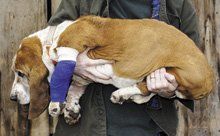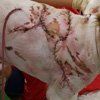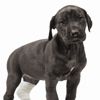Veterinary Medicine Essentials: Wound management and skin grafts
Each Veterinary Medicine Essentials package covers diagnostic steps, treatment plan guidance and the latest updates, plus resources to share with your entire veterinary team and your clients.

Wound management in veterinary patients is a basic, essential component of practice. However, selecting the appropriate lavage agent, débridement plan, skin graft or flap procedure, topical medication, drainage method, suture, and bandage are often anything but simple. No worries, though. We've got you covered with comprehensive articles on the fundamentals of wound management-as well as step-by-step guides and videos on performing many of these techniques.
Updates on wound management

After vicious attack, a sheltie is back from the brink
Oct 28, 2016
A week-long succession of wound repair surgeries results in Cody's successful recovery. ...
Treating the wounded: New strategies in healing
Mar 30, 2016
Don't just scrape by with your wound care practices. Here's the latest on promoting healthy tissue. ...
Wound repair: Dog ear correction techniques
Jun 09, 2015
Dr. Steven Swaim provides an overview of the various methods to correct this artifact that may arise when placing transposition flaps. ...
Wound repair techniques: Transposition flaps
Jun 09, 2015
Consider performing this reconstruction technique the next time you need to repair a square or rectangular wound and direct closure could result in the distortion of a body structure-or when skin for closure is only available on one side of the wound. ...
Audio: Elements of negative pressure wound therapy
Dec 02, 2013
Use the various parts of negative pressure wound therapy (NPWT) to tailor your technique to each patient's needs. ...
Wound reconstruction: Free skin grafts in horses
Jun 18, 2015
These grafts involve relocating the skin from a donor site to cover a wound and restore function and cosmesis in your veterinary equine patients. ...
Understanding wound management

CVC Highlight: 4 veterinary fundamentals of superficial wound healing
Stop infection and speed healing with these wound cleaning and bandaging strategies for veterinarians. ...
CVC highlight: Wound therapy: The positives of negative pressure
Dr. Adin discusses a state-of-the-art wound treatment that helps trauma patients heal faster. ...
Basic principles of wound management (Proceedings)
Dogs and cats are very commonly presented for management of acute or chronic wounds in veterinary practice. ...
Just Ask the Expert: Am I using skin staples for wound closure correctly?
The primary advantage staples provide over sutures is rapid closure. ...
Superficial cosmetic surgery and wound management (Proceedings)
This text is not intended to cover each and every aspect relating to wounds presented in veterinary medicine. It is, however, designed as a simplified handbook, which will assist members of the veterinary medical team in properly assessing patients and their wounds. ...
Research Updates: Using a scrotal mesh graft to repair degloving injuries
The results of this study provide support for various treatment strategies based on clinical presentation, owner finances, and the clinician's competency. ...
Surgery STAT: Using active drains in wound management
The use of active drains enhances the efficiency and minimizes the morbidity of wound drainage. Their use is indicated for removal of pre-existing fluid, ablation of dead space and prevention of anticipated fluid accumulation. ...
Performing wound management techniques

Wound repair techniques: Single pedicle advancement flaps
Consider this skin reconstruction technique in patients with square or rectangular defects. This method is especially advantageous when there is skin available on only one side of a wound. ...
Skills Laboratory: Wound repair techniques-Pinch/punch grafts
When surrounding tissue can't cover a defect, consider using these grafts for wound closure. ...
Skills Laboratory: Wound repair techniques-Strip skin grafts
A step-by-step guide to this simple way to repair wounds in which local tissue is not available for closure. ...
Skills Laboratory: How to perform a caudal superficial epigastric flap
Use this axial pattern flap to treat ipsilateral or contralateral wounds on the perineum, hindlimbs, or mid torso. ...
Skills Laboratory: Reconstructive surgery techniques, Part 1: Presutures for skin stretching
Presutures are Lembert sutures placed in healthy skin on either side of a lesion. Placed several hours before the lesion is debrided or excised, these sutures stretch the skin around the lesion. ...
Skills Laboratory: Reconstructive surgery techniques, Part 2: Adjustable horizontal mattress suture
The adjustable horizontal mattress suture is indicated primarily for limb wounds that are either relatively new or are in the wound contraction phase and in which the edges cannot initially be apposed. ...
Skills Laboratory: Reconstructive surgery techniques, Part 3: Multiple punctate relaxing incisions
Multiple punctate relaxing incisions are small parallel, staggered incisions made unilaterally or bilaterally (usually bilaterally) in skin adjacent to a wound to relieve the tension associated with wound closure. ...
Skills Laboratory: Reconstructive surgery techniques, Part 4: Full-thickness mesh skin grafts
A full-thickness mesh graft is a sheet of skin that includes only the epidermis and the entire dermis and is fenestrated to allow for expansion and drainage. ...
Skills Laboratory: Reconstructive surgery techniques, Part 5: Walking sutures
Walking sutures are tension-type sutures that can be used to close large skin defects in areas where sufficient skin surrounds the wound that can be moved or stretched to close the wound. ...
Skills Laboratory: Reconstructive surgery techniques, Part 6: Rotation skin flaps
Rotation skin flaps are circle-shaped flaps that are useful in closing triangular skin defects in which skin for closure is only available on one side of the defect. ...
Tools and tips for the team

Idea Exchange: Let pet owners see under the bandage
Showing pet owners what's under their pet's bandage to show the pet's progression of healing. ...
Idea Exchange: Keep bandaged paws clean with plastic wrap
A practical solution for keeping bandaged paws clean. ...
Wound management for technicians (Proceedings)
Dogs and cats are very commonly presented for management of acute or chronic wounds in veterinary practice. ...
Idea Exchange: Getting ear bandages to stay in place
I've found bandaging an ear after an ear hematoma repair to be a challenge. ...